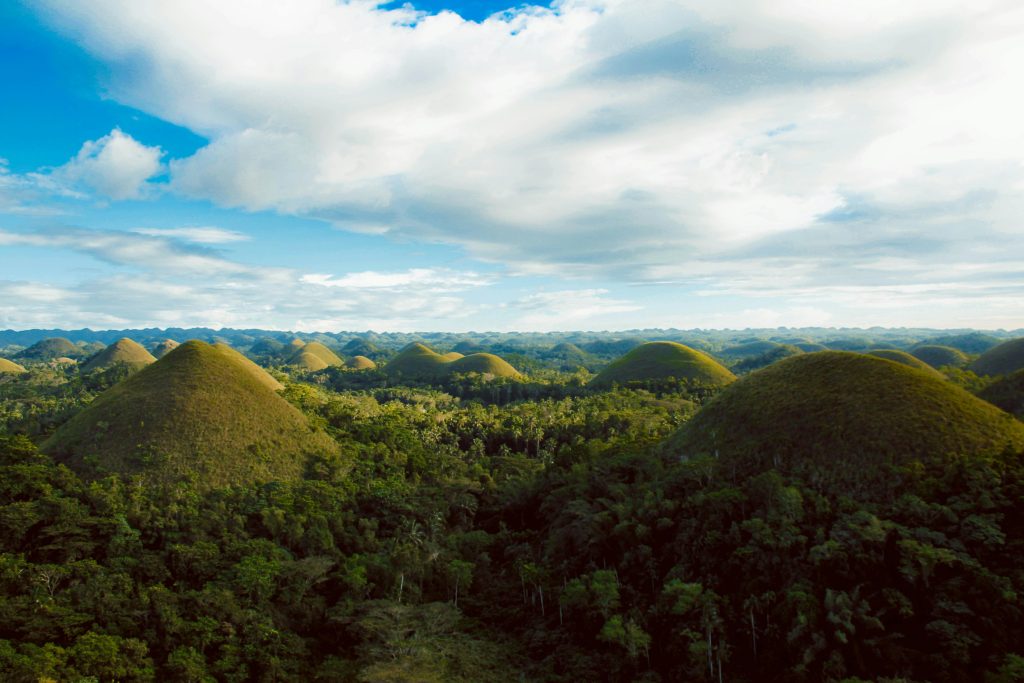Located in the central part of the Philippine island of Bohol, the Chocolate Hills is one of the most remarkable and distinct landscapes in the world. This unique geological formation consists of over 1,200 conical hills that, during the dry season, turn brown, creating the appearance of a vast, chocolate-colored landscape. The striking natural beauty of the Chocolate Hills makes it a must-visit destination for nature lovers and photographers alike.
- A Stunning Geological Formation:
The Chocolate Hills are a collection of more than 1,200 individual mounds, varying in height from 30 to 50 meters, scattered over an area of approximately 50 square kilometers. The hills are made of limestone covered with grass, which, during the dry season, turns a rich brown color, giving the landscape its chocolate-like appearance. The natural symmetry of these conical hills, stretching across the horizon, creates a surreal and otherworldly view that is unmatched by any other natural formation in the world. - The Mysterious Origin:
The exact origin of the Chocolate Hills remains a subject of debate among scientists and geologists. One widely accepted theory suggests that the hills were formed over millions of years from the uplift of coral deposits and the erosion of limestone. Over time, rainwater and wind have shaped the hills into their current conical form. Local legends also offer colorful explanations, including the story of a giant who supposedly formed the hills as a result of his battles and the transformation of his tears into these unique mounds. - Best Time to Visit:
The Chocolate Hills are most famous for their dramatic transformation during the dry season. From December to May, the grass covering the hills dries out, and the once-green hills turn brown, resembling piles of chocolate drops. This natural phenomenon is a sight to behold, and many visitors come specifically during this period to experience the “chocolate” effect. However, the area is equally captivating during the rainy season, when the hills remain lush and green, providing a contrasting yet equally stunning landscape. - A Popular Tourist Destination:
The Chocolate Hills have become one of the most famous tourist attractions in the Philippines. Visitors can enjoy panoramic views of the hills from an observation deck located on one of the higher hills, which offers a 360-degree view of the surrounding landscape. The area is also home to walking trails, allowing tourists to explore the hills up close and learn more about the formation and history of the site. The site is surrounded by lush vegetation, which adds to its scenic appeal, making it a great spot for nature walks and photography. - Cultural Significance:
The Chocolate Hills are not only a geological wonder but also an important part of the local culture in Bohol. The hills are considered a symbol of Bohol’s natural heritage, and their unique beauty is celebrated in local folklore and art. The region has become a popular spot for eco-tourism, where visitors can explore both the natural and cultural aspects of Bohol, including local festivals, traditional dances, and crafts inspired by the hills.
Conclusion:
The Chocolate Hills of Bohol offer a rare glimpse into the fascinating beauty and mystery of nature. Their unusual conical shapes, combined with the dramatic transformation during the dry season, make this landscape one of the Philippines’ most iconic landmarks. Whether you’re a nature enthusiast, a photographer, or simply someone in search of a unique destination, the Chocolate Hills offer a natural wonder that is truly unforgettable.

